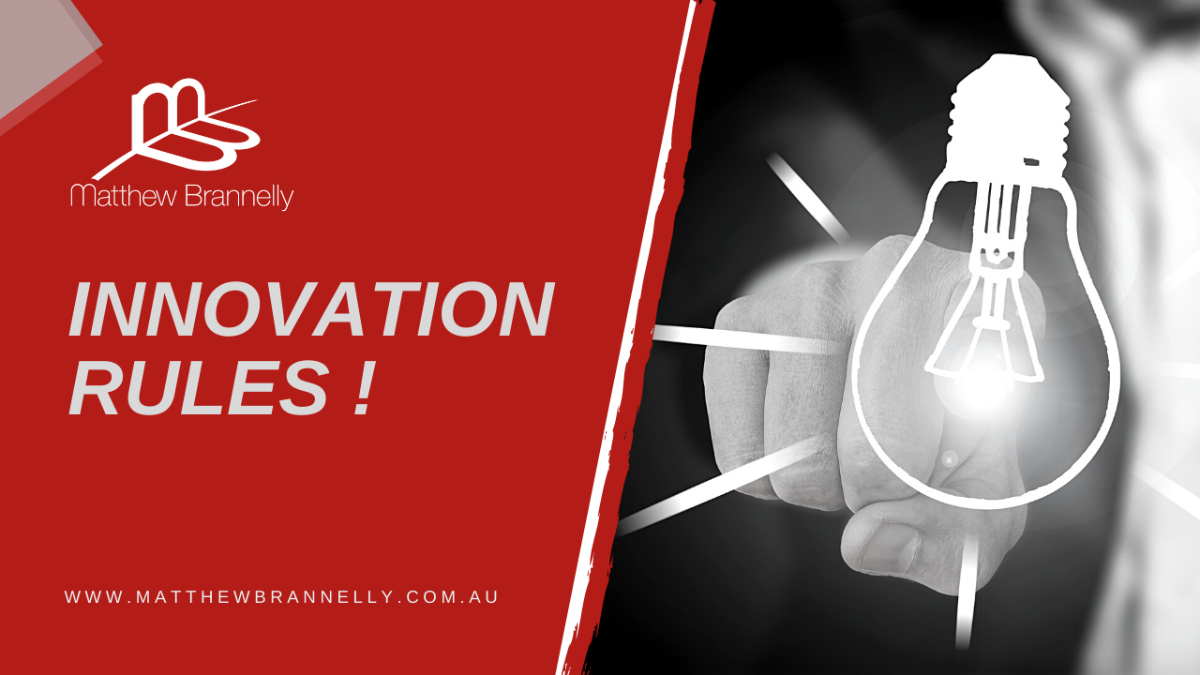I have been drawn into helping solve other business’s problems ever since I stepped away from my full-time role in a family business around 10 years ago. In doing so, I have developed a knack for disrupting the status quo; a process now widely referred to as innovation.
Supporting this effort is my formal qualification in Economics, which is fundamentally based on using the past to predict the future. I have adapted and evolved this training into the ability to investigate an industry or business, by using the past as a guide to establish a benchmark for the present and possible future and then seek new solutions to overcome current challenges and roadblocks to realizing a new possibility.
Challenges to realizing this new, grander reality tend to involve a lack of sales, finding new markets, new partners, creating efficiencies and developing exciting new products and services.
But what is innovation exactly?
Innovation is defined as the practical implementation of ideas that result in the introduction of new goods or services or improvement in offering goods or services; resulting in “a new or changed entity realizing or redistributing value”.
It is obvious that most small businesses need to innovate, as this is how they break into their markets in the first place, but even larger corporations often have innovation as a KPI in performance standards for employees and contractors.
Innovation as a “deliverable”
Managing and delivering to this is difficult as most people are neither trained nor comfortable with innovation. It is hard to quantity, and it is not traditionally learned. It is more of a lived experience.
Yet, being creative and innovating is enjoyable in a social environment, so what is the problem?
From my experience working with both for profit and for purpose businesses, here are my key Innovation Rules that I have found to be essential to creating a supportive environment for innovation to occur:
- Accept that mistakes will happen.
Trial and error is still the ultimate learning tool. Marketing gurus call it feedback when testing different combinations to see what combination yields the best results. They are paid very well to get it wrong most of the time before striking the gold. - No boundaries.
No idea is bad, and nothing is off limits. - The boss isn’t in the room.
In an innovation session where ideas are discussed, often called brainstorming, titles stay at the door. Employees will otherwise be more focused on impressing the boss and not embarrassing themselves rather than the problem at hand. - All in
Everyone involved in the process must be focused on the issue. This means select the environment, the process, and the leader carefully. No mobiles, an agenda and a framework are a good start. - Define and Reward Success
Create an incentive program for the team, not individuals, to reward success. Then define what success looks like - Persistence
You rarely achieve brilliance overnight. Whether it’s sport or business, persistence usually wins over relying on a moment of brilliance. So plan the innovation process with a medium term agenda. Don’t expect miracles in 2 months. - Adopt the Kaizen Approach
Kaizen is a Japanese term meaning “change for the better” or “continuous improvement.” It is a Japanese business philosophy regarding the processes that continuously improve operations and involve all employees. Kaizen sees improvement in productivity as a gradual and methodical process.
The same process of gradual improvement can be applied to innovation. - Eye on the prize
Clearly define the goal or purpose of the project . If you can’t visualize it, our brains will find it hard to work the problem. - So what?!
Why is the problem important? Why should it be prioritized over all your other priorities . Your team needs to be passionate about finding a solution. - Leadership
The last and most important element is the leader’s ability to provide the framework, inspiration and environment for the team working on innovation.
Innovation leadership is not always the boss
In fact it is usually not the boss. The boss is embedded in running the operation as it now is, and it is often hard to “see the wood from the trees” when deep in the operational concerns of the current state. A select few can do both, but they are rightfully acknowledged for being superhuman and geniuses.
My journey started when in my early 20’s, I was asked to set up a business organization for young people in business wanting to learn, build relationships and grow – both professionally and personally. Without any road map or understanding of what I have since learnt, I established the Brisbane Junior Chamber of Commerce in 1983 www.linkedin.com/company/brisbane-junior-chamber-of-commerce/mycompany), then several years later helped introduce a new semi professional sport to Australia and became the Founding Chairman of the Brisbane Bandits Baseball Team www.linkedin.com/company/brisbane-bandits.
In the years following, I worked with a lot of professional firms and SMES, many of which are outlined here www.matthewbrannelly.com.au/who-matthew-helps and include several that have become market leaders with unique solutions such as:

In my future Innovation series, I will showcase some of these initiatives in the hope it may inspire you to set up or re energize your own innovation program. If you need someone to bounce ideas off, drop me a line.

